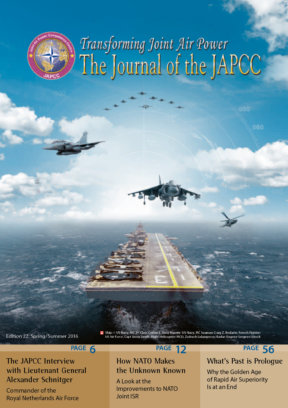Introduction and Background
Since the beginning of armed conflicts, weapons have been used to gain advantage on the battlefield. The chronological and developmental successor of arrows, catapults, and cannons, Ballistic Missiles (BM) entered the battlefield in 1944 and rapidly evolved into an instrument of global force projection, with the capability to deliver mass destruction over long distances with great accuracy. Considering the short flight times and therefore available reaction times, BM are a substantial threat for nations, regions and global organizations.
To be better prepared for a potential BM threat, nations with Ballistic Missile Defence (BMD) capabilities have undertaken numerous exercises, war games and studies. Based on a unilateral US BMD exercise executed by the US Joint Staff’s Joint Theater Air and Missile Defense Organization (JTAMDO) in the late 1990s, Nimble Titan (NT) was created in 2002. In 2003, the United Kingdom entered as an observer and participated in 2004 and 2005, rendering NT a bilateral but still classified event. These early exercises considered themes such as interceptor shot doctrine, automated battle management aids, decision support tools, combined early warning, offence-defence integration, weapons allocation and release authorities, and Command and Control (C2) structures, all of which represented challenges on a mainly tactical level.
In 2006, the NT program was transferred to US Strategic Command (USSTRATCOM), which tasked the Joint Functional Component Command for Integrated Missile Defense (JFCC IMD) to manage and execute the war game.1 After NT 06, the focus shifted from tactical matters to multinational policy issues at the operational and strategic level. Furthermore, to allow for broader participation, NT became an unclassified event. Since then, NT has grown from a small bi-lateral event to include 26 participating NATO and Non-NATO nations and organisations. JAPCC became the latest NT member in November 2015 after being accepted by the NT Steering Committee. Due to NT’s unique and complex composition, this article will highlight how a NT campaign is being planned and executed and why it plays such an important role in the global understanding of BMD. Furthermore, it should become clear that NT is constantly evolving and improving based on lessons learned from past campaigns.
In accordance with the NT Campaign Design Standing Operating Procedures2, a regular campaign spans a time frame of two years, during which all planning, designing, execution and evaluation events take place. At the start of each campaign, participating countries offer to host single events, making NT truly a global endeavour.
Campaign Development, Design and Planning
Every NT campaign starts with a Campaign Concept Development Conference (CDC), at which all NT participants bring forward their key objectives for the upcoming campaign. All objectives and potential carry-overs from previous campaigns are evaluated and grouped into main and sub-objectives. NT 16 comprises four main objectives with a total of 22 enabling sub-objectives. Here is a sample of the NT 16 objectives3:
- Policy (POL)-1 Examine national and multinational BMD decision making processes and their effects on planning, design and execution;
- POL-1.2 Identify conditions and factors for enabling effective cooperative action, including formal information exchange processes, between intra-, inter-, and non-organization partners;
- POL-1.8 Examine the second order effects and implications of anticipatory self-defence;
- Planning (PLN)-1 Explore the effects of policy guidance on defence design;
- PLN-1.3 Identify implications, gaps, potential risks and mitigation options in comparative defence designs;
- PLN-1.6 Explore the benefits and limitations of BMD and non-BMD state contributions in planning and design of BMD architectures.
The developed list of objectives is then built into a suitable campaign construct. Some objectives are best evaluated in a dynamic war game, while others lend themselves more to a Table Top Exercise (TTX), Limited Objective Experiment (LOE), or Seminar. Due to the extensive NT participant list, there are, next to national territories, always four regional focus areas to be evaluated and stimulated. These are the NATO and non-NATO European Region, the Gulf Region, the Asia-Pacific Region, and the North American Region. Since NT 12, the campaign design has striven to create a global scenario as well. To maintain the experimental character of NT, the time scope is always ten years in the future, which allows for experimental national policies, weapon systems, C2 structures, constructs, and concepts. Traditionally, the main focus of all NT campaigns has been ballistic missile defence on a regional and global scale. However, the current objectives include Integrated Air and Missile Defence (IAMD) as well. This is because the community acknowledges an isolated view on BMD might not clearly identify potential problem areas where air defence and missile defence overlap. Due to the experimental character of NT itself, the participants can free themselves to a certain extent from their current national policies during the campaign events and try out new approaches to support the development of future policy or doctrinal documents.
The CDC determined the current NT 16 campaign will be made up of four major events, and the campaign will stay on the pol-mil strategic level with an operational background. Each main event has a Planning and Design Workshop prior to its execution, which involves the NT core team and representatives of the NT participant nations. Due to the highly professional input of the NT participants and the extensive historical NT knowledge, NT events steadily evolve and adapt to fulfil participant expectations. The use of outstanding tools, like skilfully-produced NT Television news clips, very capable simulation and visualization support by the US Missile Defense Agency (MDA) and experienced facilitators to stimulate NT injects during the various events, increases the professionalism and value of the NT game play.
Campaign Main Events
The first event during the NT 16 campaign was a LOE, which took place in Seattle, Washington. Participants were tasked with creating a working definition of IAMD for the NT environment to be used in subsequent NT events. Every nation, organisation and region had definitions for IAMD, so the challenge was to find a viable common denominator that could be utilized within NT game play. The LOE was executed as a facilitated seminar with a mainly global forum, but it also included some regional excursions. The player actions and interactions were observed by the Design, Analysis and Reporting Team (DART) for later analysis.
The results were used during the Planning Phase Event in Soesterberg, Netherlands. Here, military planners and policy players created defence designs against regional and global threats. These threats were designed mainly by the Wargame Control Group (WCG), which, in conjunction with the DART, creates the historical background of the crisis, the enemy order of battle and all needed injects to stimulate realistic and productive game play. The biggest challenge for the WCG is to define a scenario that stimulates all objectives and is realistic enough to be believable yet removed enough from reality to satisfy all participant caveats. Overall, the scenarios created by the WCG have been spot-on and have created some interesting discussions within the NT community. This demonstrates how important the player audience is to the execution events and it is of critical importance the appropriate audience also participates in the CDC and design workshops to obtain the optimal benefits from the campaign. Unclear objectives and desired injects that are not brought to the table cannot be played during the NT events.
In the design and planning event for the main war game, which was hosted by US Pacific Command (USPACOM) in San Diego, participants discussed how far possible scenarios should evolve in the war game. Is a crisis situation sufficient to stimulate necessary discussions or is a full-blown IAMD conflict scenario required to achieve the goal? Due to the uncertain development of the war game, they prepared for both eventualities. The main events provide very valuable opportunities for the training audience to get a thorough understanding of multinational, cross-regional and global BMD issues. However, equally as valuable are the design and planning events for the subject matter experts who define and develop the war games, since it is a unique platform to exchange thoughts, approaches, and current problems in the field of Ballistic Missile Defence.
The main war game itself was held in Suffolk, Virginia, at the Lockheed Martin Center for Innovation, also called ‘The Lighthouse’. This outstanding facility once again hosted the 26 nations and organisations participating in the so-called hybrid war game. Since it is difficult to guarantee the achievability of all given objectives in a pure free-flowing war game, it used a partly facilitated format with mostly pre-written injects. The flexibility and dynamics in the game play was created by the interaction of the exercise audience and the white / red cell players in the WCG. Steady feedback from the DART allowed the WCG to steer the game play towards the objectives. The red and white cell players are experts in their fields, which makes the interaction during the game play very realistic for the participant audience and allows a certain degree of freedom in the scenario development for the WCG during the whole event. Also, in cases where discussions in regional or global consultation forums create much valuable input, the game play is flexible enough to allow for extended dwell-time on those specific topics.
Each NT Campaign is concluded with an NT Capstone Event, usually a war game as described above, which has traditionally had a distinguished visitor day. This allowed senior leaders, be they military flag officers or their foreign affairs civilian equivalents, to see NT in motion and experience the live war game. However, this option, with its high-level footprint, reduced the actual game time and denied the presentation of analysed results of the war game to those senior leaders. As a result, the June 2014 After Action Review Team recommended hosting a separate Senior Leadership Seminar (SLS) in June 2016. This will give the benefit of retaining the full use of all war game time as well as the possibility of presenting the thoroughly analysed conclusions of the entire NT 16 campaign.
This year’s SLS, followed by an after action review of all events will conclude the NT 16 campaign and will also be used to obtain valuable senior leader guidance to aid in shaping the future of NT. All results of the NT events will be presented in the final NT campaign report and in the other subordinate event reports. Also, important individual findings will find their way into the NT Implementing Instrument, which is a collection of wisdom accrued over many NT campaigns. This document has, in the past, proven to be highly valuable and has contributed towards official national policy documents. The overall results of NT can then serve as a reference or foundation for the definition of new national or organisational documents.
Outlook and Summary
In September 2016, the CDC for NT 18, during which the next evolution of the NT series will be defined, will take place in Tokyo. Overall, NT provides a truly unique opportunity to learn about global approaches towards Ballistic Missile Defence and IAMD policy. No other campaign presents better grounds for international networking in the BMD arena on the political-military level. It is eye-opening to work with regions that have a more imminent threat and threat perception than central Europe. NT is the only BMD campaign with a strategic-level approach on a global scale, where political, legal and military challenges can be discussed equally.
The reality of ballistic missiles, especially in the realm of current and upcoming technology and means of physical and digital proliferation, can only be countered on a global scale. It is up to the participating nations to maximize their benefit from NT by ensuring that the appropriate players and experts participate in the individual events. The unique composition of nations, experts, and decision makers, along with the correct understanding of NT’s experimental nature, makes NT a valuable tool in obtaining insight into factors that will impact the evolution of future BMD operations.












